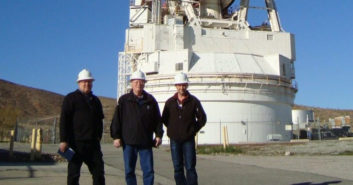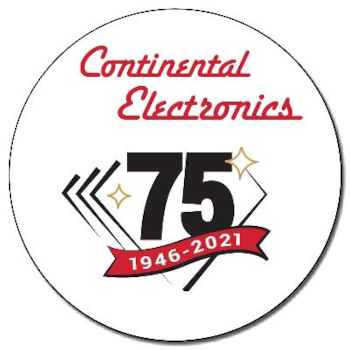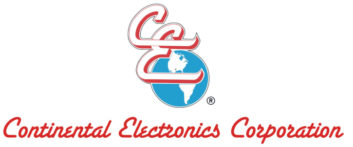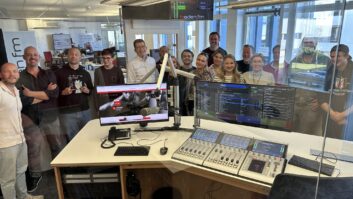
Continental Electronics says high-frequency radio communications can be used to protect the satellite network that provides connectivity for America’s military.
The manufacturer, which is noting its 75th anniversary, notes that satellites are susceptible to jamming, eavesdropping and futuristic warfare tactics such as electronic A2AD, or “Anti-Access/Area Denial,” attacks.
But it says Wide-Band High-Frequency (WBHF) technology in particular can help ensure secure communications.
Given Continental’s history in broadcasting, Radio World caught up with President Dan Dickey for an emailed update.
Radio World: Dan, happy 75 to Continental. Radio engineers familiar with Continental will be interested in learn about what the company is doing in the area of wide-band high-frequency technology.
Dan Dickey: For Beyond Line of Sight Communication (BLOS), the military has been using high-frequency technology since the 1930s. Typically, these radios would transmit with a bandwidth of 3 kHz. This equates to a slow 9600 bps data transfer rate.
 When you put this into perspective, this is slower than dial-up modems we used in the early 1990s.
When you put this into perspective, this is slower than dial-up modems we used in the early 1990s.
CEC has developed a state-of-the-art, solid-state transmitter capable of operating at 48 kHz, which equates to a transfer rate of 240 kpbs. This provides a much faster data link, and with the known resilience of HF BLOS communication, old HF communication networks are becoming new technology again. It has become a resilient alternative to vulnerable satellite communication systems.
CEC’s digital HF solid-state transmitters incorporate many features that CEC has proven in the field for other transmission bands for other applications. CEC has applied its vast digital signal processing experience to create a very linear, low-noise system. CEC’s HF broadband experience makes operating anywhere in the 2 to 30 MHz range fast and effortless.
In addition, by implementing our proven solid-state amplifier liquid-cooling approach, CEC is offering an extremely efficient and power-dense solution, requiring much less floor space than previous air cooled systems.
RW: Who are the typical users of this technology?
Dickey: The military and disaster response teams use high-frequency radios for communications. This is a very robust and secure form of long-distance communication that does not rely on satellites. Instead, it uses multiple HF transceivers in various locations to form a digital wireless network, except the distances between nodes is hundreds or thousands of kilometers.
With the growing threat of satellite jamming and manipulation, HF communication is seen as a low-cost secure alternative. However, higher transmission bandwidth is needed to carry the desired payloads across long distances. In the past, 3 kHz was a typical bandwidth for the analog HF communication links. With WBHF, the payload bandwidth is extended up to 48 kHz allowing more information to be transmitted increasing the value of this robust form of communication.
RW: Can you give an example of a recent sale or installation that typifies this application?
Dickey: We are in the process of assembling a prototype system for testing and evaluation. We will be releasing more information on our solution in coming months.
RW: A common comment we hear is that “shortwave is dying.” You presumably feel otherwise, so how would you answer such comments?
Dickey: It is true that over the past several decades, the number of shortwave broadcasters has reduced.
Our opinion here at Continental is that many of the European and American broadcasters believe that they can reach their audience or listeners via the internet.
However, this is not true for many listeners outside of North America, Europe and developed Asian countries, such as Korea and Japan.
Imagine how many billions of people in Asia, Africa and South America do not have access to the internet. Typically the broadcasters who want to reach these people across oceans and borders are either nonprofit or government broadcasters. People in these regions rely on shortwave radio to receive information. Many of these systems have been in operation for many years and we are seeing an increase in demand to upgrade these transmitter systems.

RW: Is Continental still active in making and selling to the broadcast marketplace?
Dickey: Absolutely. CEC remains true to our broadcast origins back to our founding in 1946. We continue to supply shortwave transmitter systems around the world, with our most recent installations in Korea, Saudi Arabia and most recently, a complete 500 kW transmitter system in the U.S. CEC also re-entered the TV market in 2017 with our CTX line of transmitters.
RW: What else should we know about Continental’s current direction and business strategies?
Dickey: Organized in 1946, CEC is celebrating our 75th anniversary this year. There are thousands of CEC transmitters installed around the world. Today, Continental Electronics offers a full range of products for LF, VLF, HF, VHF, FM, S and X Band as well as high-power amplifiers for any applications in such markets as medical, science, industrial, government and military communications, space communications, PNT (navigation), and radar to name a few.
When customers need a high-power RF solution for their application, they come to Continental Electronics.







